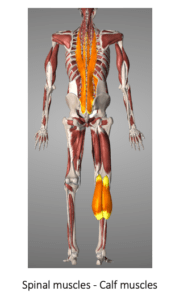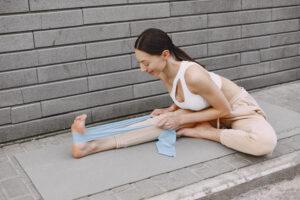Lower back pain is a pervasive concern that affects individuals of all ages and lifestyles. While many factors contribute to this discomfort, one often overlooked connection lies in the intricate web of fascia and muscles known as the superficial back line myofascial chain. In this blog post, we will unravel the relationship between the calf muscles and lower back pain by examining the role of the superficial back line and how its dynamic interactions influence our musculoskeletal health.

Understanding the Superficial Back Line Myofascial Chain:
The superficial back line is a continuous chain of fascia and muscles that extends from the plantar fascia of the feet to the occiput at the base of the skull. It plays a crucial role in maintaining posture, providing stability, and facilitating movement. The myofascial connections within this chain can influence distant areas of the body, including the lower back.
The Calf-Lower Back Connection:
- Fascial Continuity:
- Fascia, the connective tissue that surrounds muscles and organs, forms a continuous network throughout the body.
- The superficial back line includes the fascial connections between the calf muscles, hamstrings, glutes, and paraspinal muscles, creating an interconnected system.
- Tension Patterns:
- Imbalances or restrictions in the calf muscles can create tension patterns along the entire superficial back line.
- Tightness in the calves may contribute to increased tension in the hamstrings, affecting the pelvis and lower back.
- Postural Dynamics:
- The calf muscles, particularly the gastrocnemius and soleus, influence ankle mobility and, subsequently, overall posture.
- Altered foot and ankle mechanics can lead to compensatory movements in the pelvis and lumbar spine, potentially resulting in lower back pain.
- Gait and Kinetic Chain:
- The superficial back line is engaged during walking, where the calf muscles play a vital role in propelling the body forward.
- Dysfunctional gait patterns, often associated with tight or weak calf muscles, can contribute to maladaptive changes in the lower back.

Preventive Measures and Management:
- Myofascial Release Techniques:
- Incorporate myofascial release techniques, such as foam rolling and massage, to address tension along the superficial back line.
- Target the calf muscles, hamstrings, and other relevant areas to enhance overall flexibility.
- Stretching and Mobility Exercises:
- Include regular stretching exercises for the calf muscles to maintain optimal flexibility.
- Implement dynamic mobility exercises that promote proper movement patterns within the superficial back line.
- Strength Training for Stability:
- Engage in strength training exercises that target the calf muscles, hamstrings, and core to enhance overall stability.
- Focus on functional movements that mimic activities of daily living.
- Posture Awareness and Ergonomics:
- Cultivate awareness of your posture, especially during prolonged periods of sitting or standing.
- Consider ergonomic adjustments in your workspace and footwear to support proper alignment along the superficial back line.
Understanding the relationship between calf muscles and lower back pain through the superficial back line myofascial chain provides valuable insights into holistic musculoskeletal health. By addressing imbalances, promoting flexibility, and fostering stability within this interconnected system, individuals can take proactive steps to prevent and manage lower back pain. Embracing a comprehensive approach that considers the entire superficial back line will contribute to a resilient and well-balanced musculoskeletal system, promoting overall well-being and minimizing the risk of lower back discomfort.

